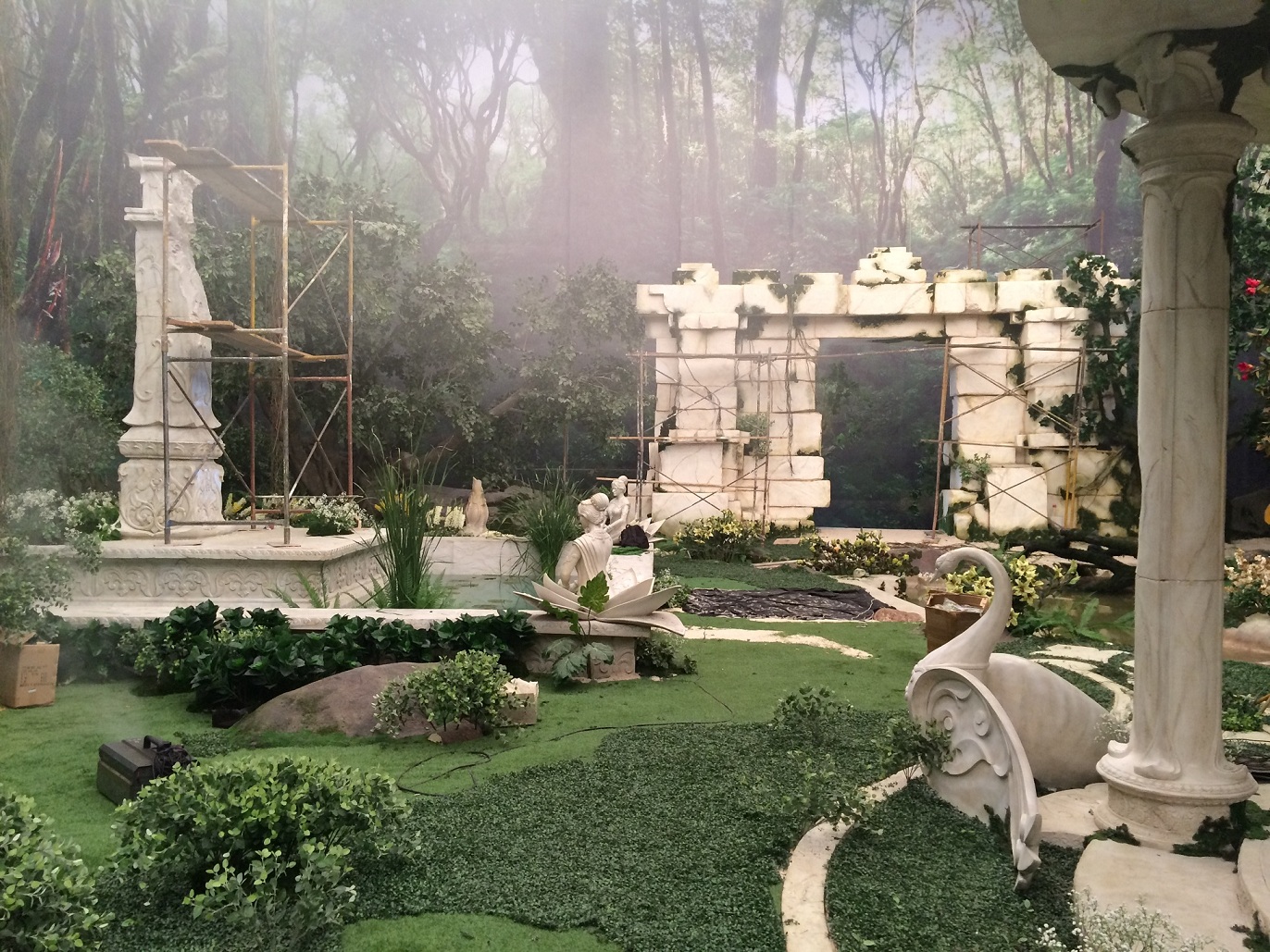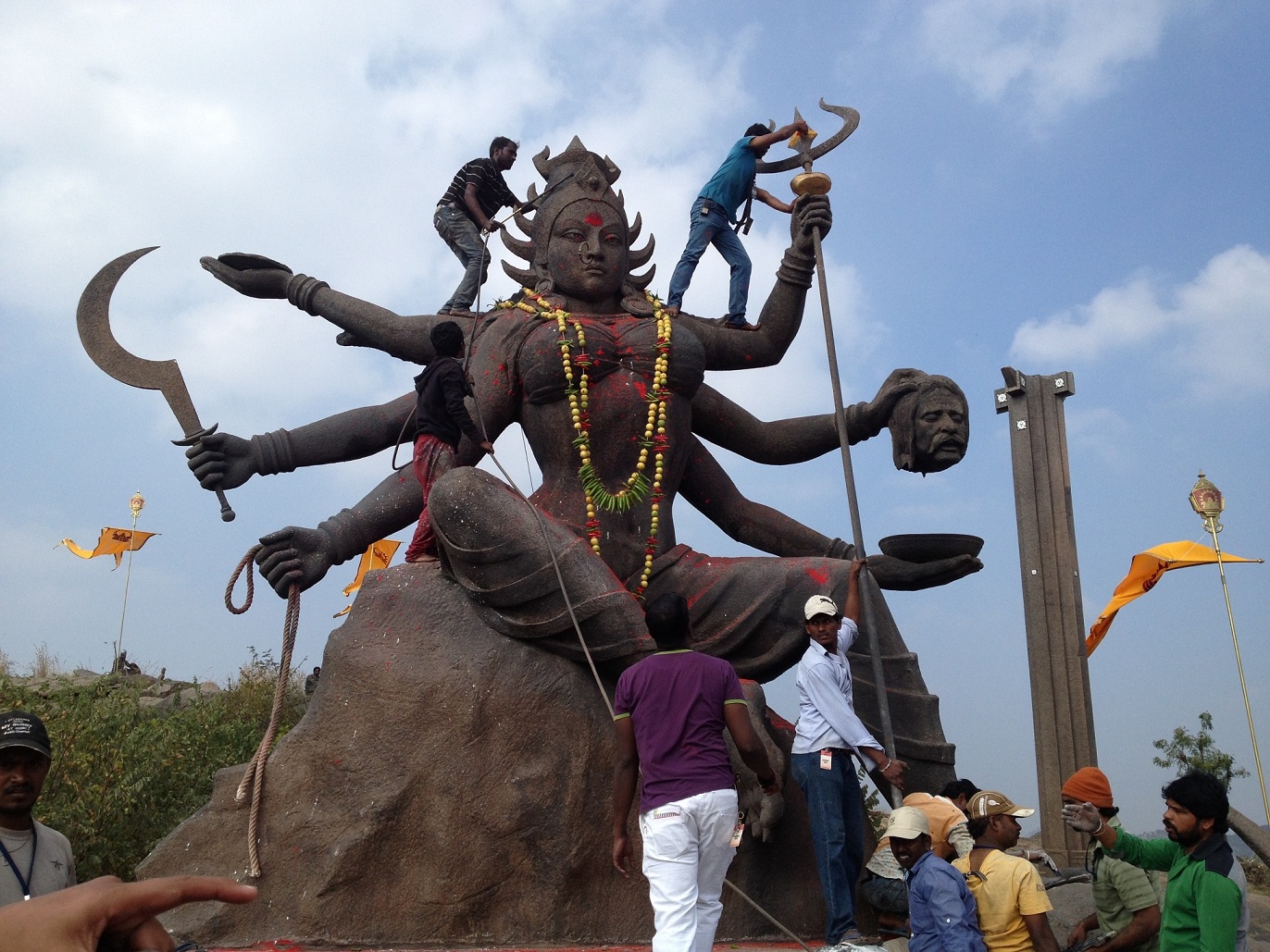The results are there for all to see. Cyril’s contributions to SS Rajamouli’s Baahubali are among the sword-and-dhotis epic’s many highlights. Praise and money have been pouring in for the first chapter of the two-part movie, which is set in a fictional world inspired variously by epics, folklore, comic books, similar Hollywood fantasy period productions and Chinese martial arts epics. Made simultaneously in Tamil and Telugu for a rumoured budget of Rs 250 crores and dubbed in Hindi and Malayalam, the July 10 release follows the battle for honour and inheritance that is waged between warring brothers, played by Prabhas and Rana Dagubatti. (Part two will be released next year). The movie has a heavyweight Telugu cast and extensive use of computer-generated imagery, but one of its most striking aspects is Cyril’s evocative sets, which include a waterfall that stretches upwards into the clouds, the Mahishmati kingdom, and elaborate weaponry and props. “This was a fictional subject, so we had the liberty,” Cyril said. “We didn’t get into any specifics since we designed everything for the film. I took this to be an advantage, and the only thing was that it needed to be believable.”

Most of Baabubali was shot at the Ramoji Film City in Anajpur near Hyderabad, said to be the largest studio complex in the world. “We had six to seven concept artists, and there were 200 people working on various sets at any time,” Cyril said. “We made close to 10,000 swords, which were stored in a separate room. We had a manufacturing factory to make the props. Everything was hand-made.”
Cyril is no stranger to scale or the creation of make-believe worlds. He has worked on several movies that offer stylised versions of reality, such as Yuva and Kalapani, but his credits include Hey Ram, Asoka the Great, Om Shanti Om and Robot, all old-fashioned spectacles featuring elaborately designed sets. One of the challenges of dreaming larger than life is that the dream needs to linger in the consciousness far beyond the movie’s release. “The challenge when I worked on Robot was that it was a science fiction story that needed to be believable rather than outlandish,” Cyril explained. “And when it came to television, the movie had to look presentable and not go out of fashion.”
Baahubali is a period movie, but is set in a past out of the pages of a screenplay rather than a history textbook. Some fact did inform the Greco-Roman-Ramoji fantasy. “When Rajamouli narrated the subject to me, he gave me an idea of its proposed scale by showing me a Photoshopped image of a waterfall,” Cyril said. “It was huge, about a hundred feet of water, and he said, this is my vision, I don’t know how we are going to shoot it, but this is how it will be in the film.”
The waterfall dominates the movie’s opening sequences, which feature the Baahubali character seeking to conquer the wall of water and the mountain from which it gushes. As Baahubali swings by a rock with just one hand and dances on the rocks as though he were a mountain goat, the question arises as to how much of the rock-face is real and how much is the result of computer-generated trickery that extended its natural height. “We shot the waterfall in Kerala, and 98 feet is real,” Cyril revealed. “We recreated eight portions at Ramoji Film City and matched these portions with the actual waterfall.” Fibre was used to simulate the rocks, while a massive tank deployed five high-pressure pumps to make the water gush down over and over again. The water was recycled during the entire shoot. “It was quite a task, but I felt that this was a challenge, which is why I got involved,” Cyril said.
Beyond the waterfall lie other wonders, such as valleys filled with flowers and frost. “All these sequences were created indoors,” Cyril said. “We imported artificial flowers worth Rs 60 lakhs from China.”

Another key set piece is the Mahishmati kingdom and its palace, characterised by phallic statues and multi-level structures with subtle but intricate carvings. “The film is happening roughly around 500 BC, and I had to take the look from something that existed from that period,” Cyril said. “We looked at Ajanta and Ellora and Mahabalipuram in the south. We used a lot of granite monolithic structures, which don’t have too much design because of their size.” The chosen colour scheme for Mahishmati was a warm, muddy shade that was neither red nor gold. “We avoided imitating any existing kingdoms, but the Tanjore temple has almost the same colours as what we have used in the film,” Cyril said.
The scale of Greek and Roman structures also influenced Mahishmati’s design – it is a kingdom designed to awe into submission. “The Greeks and Romans thought in terms of scale, and that scale is there in this film” Cyril said. “But I also wanted straight lines for Mahishmtati’s structures. I have used a lot of granite embedded with metal, and these will be seen more in the second film.”
The production design extended to the props, such as the throne, the weaponry, and the armour. The metal inlay work in the throne emphasises its solidity, for instance, while the armour has clean and bold lines to bring out their starkness. “Rajamouli has a keen eye for this sort of thing and is very particular,” Cyril said. “We had a good taskmaster.”
There are subtle differences in the head gear worn by the warring royals played by Prabhas and Rana Dagubatti to bring out their contrasting personalities. “If you look closely at Prabhas’s helmet, it has flowing lines, while Rana’s head gear is sharp-edged and spiky,” Cyril said. “We didn’t want audiences to notice these details separately, of course but we wanted an overall effect.”

Cyril’s dedication to Baahubali meant that he has worked on little else since 2012, except for the Tamil-language Lingaa. “I should thank Baahubali’s producers, without whom this film would not have happened,” he said. “We can visualise and imagine all sorts of things but there needs to be a producer who allows it to happen. Everybody has money, but you need to spend it well.” He also credited the team work that cut across all aspects of the production. “Nothing can be achieved without team work,” he said.
Cyril will resume work on the concluding chapter in Baahubali in September. After staying close to seven months in a hotel in Hyderabad, he has moved into an apartment. He has at least another six months of work to go on the second shift. The challenges and obstacles on the first production are likely to crop up in the second.

Sabu Cyril.
“The most challenging scene for me was the Kali statue that you see in the war sequence,” Cyril said. “It is 28 feet high, and it had to be built and installed on a mountain top. We hadn’t finished by the time the shoot started on December 25. I worked night and day until 6am along with between 150 and 200 people, but the dye on the statue simply didn’t set. That day was simply too much for me.”
Of course, the dye set on time, and the Kali statue is an integral witness to the carnage of the battlefield. “I guess that is why they call me for such films, because I can make the impossible happen,” Cyril said.











